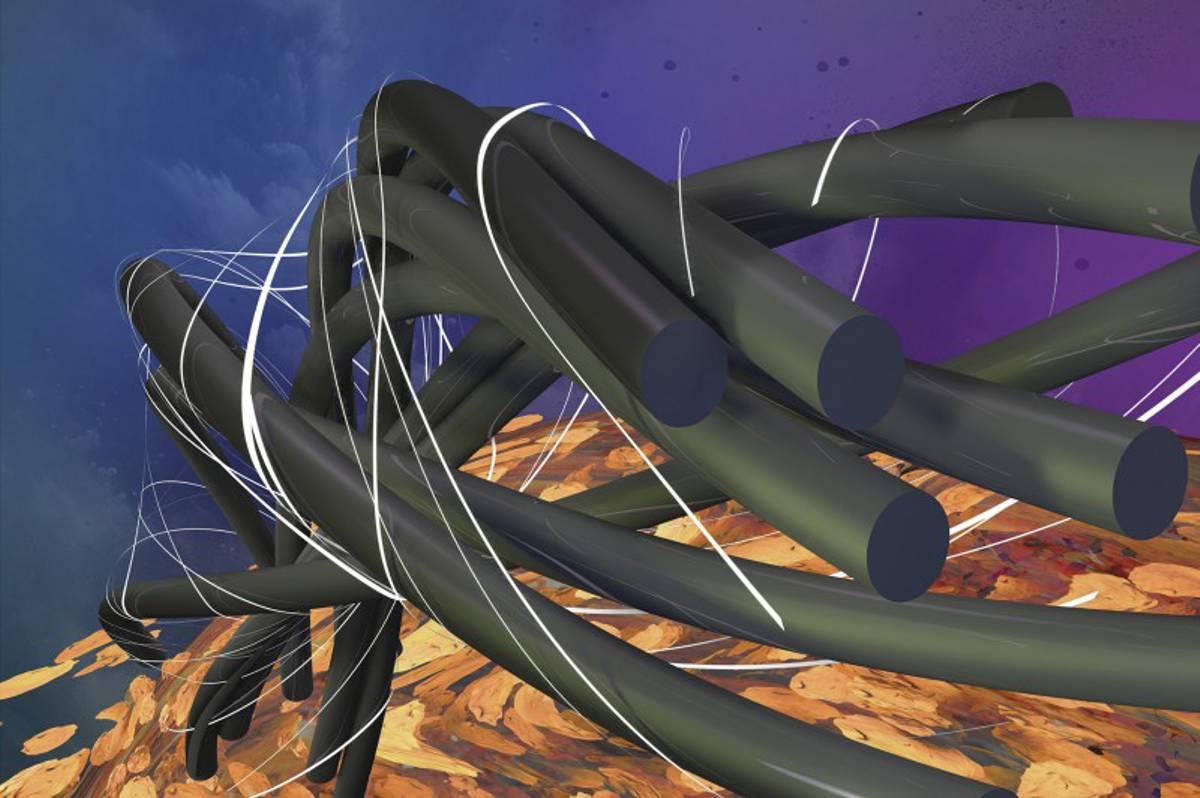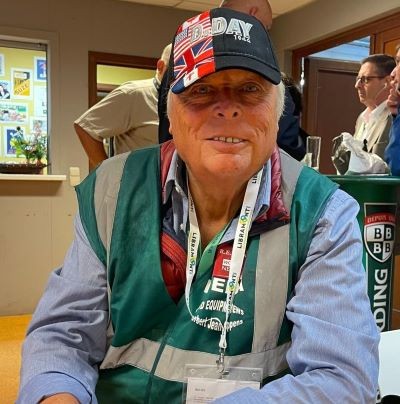R.E.News future Technology-Scientists developing Fibre-Reinforced Polymer Composite Materials
 30/04/24-FR-English-NL-footer
30/04/24-FR-English-NL-footer
Des scientifiques développent des matériaux composites polymères renforcés de fibres
 This graphic shows an unconventional approach to making widely used composite materials stronger and tougher. Thermoplastic fibres are deposited like cobwebs on top of rigid fibres to chemically form a supportive network with a surrounding matrix, or binder substance. Credit: Adam Malin/ORNL, U.S. Dept. of Energy.
This graphic shows an unconventional approach to making widely used composite materials stronger and tougher. Thermoplastic fibres are deposited like cobwebs on top of rigid fibres to chemically form a supportive network with a surrounding matrix, or binder substance. Credit: Adam Malin/ORNL, U.S. Dept. of Energy.
Des scientifiques du laboratoire national d'Oak Ridge du ministère de l'Énergie ont développé une méthode qui démontre comment les matériaux composites polymères renforcés de fibres utilisés dans les industries de l'automobile, de l'aérospatiale et des énergies renouvelables peuvent être rendus plus solides et plus résistants pour mieux résister aux contraintes mécaniques ou structurelles au fil du temps.
Les composites ont déjà de nombreux avantages. Ils sont solides et légers par rapport à leurs homologues métalliques. Ils sont également résistants à la corrosion et à la fatigue et peuvent être adaptés pour répondre à des exigences de performances industrielles spécifiques. Cependant, ils sont vulnérables aux dommages dus à la contrainte car deux matériaux différents – des fibres rigides et une matrice souple, ou une substance liante – sont combinés pour les fabriquer. L'interphase entre les deux matériaux doit être améliorée en raison de son influence sur les propriétés mécaniques globales des composites.
Sumit Gupta de l'ORNL a déclaré que l'équipe de recherche avait déposé des nanofibres thermoplastiques comme des toiles d'araignées pour créer chimiquement un réseau de soutien qui renforce l'interphase. Leur technique diffère des méthodes conventionnelles consistant à revêtir les surfaces des fibres avec des polymères ou à fournir un échafaudage rigide pour améliorer la liaison entre la fibre et la matrice, qui se sont révélées inefficaces et coûteuses.
Gupta a déclaré que lui et l'équipe ont soigneusement sélectionné les nanofibres et le matériau de matrice pour créer un échafaudage ou un pont de grande surface comme voie de transfert de charge, un mécanisme par lequel la contrainte est transmise entre les fibres de renforcement et le matériau de matrice environnant.
« Notre procédé permet au matériau de résister à des contraintes plus importantes. En utilisant cette approche simple, évolutive et peu coûteuse, nous sommes en mesure d’augmenter la résistance des composites de près de 60 % et leur ténacité de 100 % », a-t-il déclaré.
Les composites fabriqués grâce à un tel progrès pourraient améliorer d'innombrables choses appliquées dans notre vie quotidienne, des véhicules aux avions.
"Une fois que nous avons connu la science fondamentale et la chimie derrière ce que nous avions développé, nous sommes devenus convaincus que nous disposions d'une technologie appliquée précieuse", a déclaré Christopher Bowland de l'ORNL. « La découverte de nouvelles technologies et la compréhension des sciences fondamentales constituent un aspect de notre travail. Pourtant, une autre facette de la recherche appliquée consiste à explorer comment la technologie peut être traduite en applications concrètes au bénéfice de la société. En collaboration avec l’équipe de transfert de technologie d’ORNL, un brevet a été déposé sur cette recherche afin de potentiellement traduire la technologie auprès de partenaires commerciaux.
Bowland a déclaré que les recherches futures portent sur différents systèmes de fibres et de matrices possédant des groupes chimiques compatibles, et que les chercheurs prévoient d'effectuer davantage d'études sur les nanofibres elles-mêmes pour augmenter leur résistance.
L’article détaillant cette recherche dirigée par l’ORNL, « Enhancing Composite Toughness Through Hierarchical Formation », est publié dans Advanced Science et figure sur la couverture intérieure de la revue.
Cette étude fait partie du nouveau programme de base Composites 2.0 du programme de technologie des matériaux du Bureau des technologies des véhicules au sein de l'Office de l'efficacité énergétique et des énergies renouvelables du DOE, ou VTO-EERE. Le programme, dirigé par l'ORNL avec les laboratoires participants Pacific Northwest National Laboratory et National Renewable Energy Laboratory, s'efforce d'améliorer l'efficacité des véhicules grâce au développement de matériaux avancés.
"Une voie pour atteindre l'objectif du programme consiste à remplacer les composants en acier plus lourds par des composites en fibre de carbone, qui offrent actuellement le meilleur potentiel de réduction de poids", a déclaré Amit Naskar, responsable du groupe Carbone et Composites d'ORNL. "Le développement d'interphases plus solides et plus résistantes dans des composites renforcés de fibres hautes performances peut réduire la fraction volumique de fibres avec une réduction de masse améliorée et une rentabilité ultérieure des structures composites."
L’équipe de recherche a utilisé les ressources de l’installation utilisateur Compute and Data Science de l’ORNL pour des études informatiques afin de comprendre les forces de liaison fondamentales. L'équipe a également utilisé la microscopie à force atomique au Centre des sciences des matériaux nanophases, ou CNMS, pour caractériser la rigidité de l'interphase conçue. Le CNMS est un établissement utilisateur du DOE Office of Science à l'ORNL.
UT-Battelle gère ORNL pour le Bureau des sciences du DOE. Le plus grand partisan de la recherche fondamentale en sciences physiques aux États-Unis, l'Office of Science s'efforce de relever certains des défis les plus urgents de notre époque.
NJC.© Info Oak Ridge National Laboratory
--------------------------------------------------------------------------------------------------------------------
 30/04/24-English
30/04/24-English
Scientists developing Fibre-Reinforced Polymer Composite Materials
 This graphic shows an unconventional approach to making widely used composite materials stronger and tougher. Thermoplastic fibres are deposited like cobwebs on top of rigid fibres to chemically form a supportive network with a surrounding matrix, or binder substance. Credit: Adam Malin/ORNL, U.S. Dept. of Energy.
This graphic shows an unconventional approach to making widely used composite materials stronger and tougher. Thermoplastic fibres are deposited like cobwebs on top of rigid fibres to chemically form a supportive network with a surrounding matrix, or binder substance. Credit: Adam Malin/ORNL, U.S. Dept. of Energy.
Scientists at the Department of Energy’s Oak Ridge National Laboratory have developed a method that demonstrates how fibre-reinforced polymer composite materials used in the automotive, aerospace and renewable energy industries can be made stronger and tougher to better withstand mechanical or structural stresses over time.
The composites already have many good things going for them. They are strong and lightweight relative to their metallic counterparts. They are also corrosion and fatigue resistant and can be tailored to meet specific industrial performance requirements. However, they are vulnerable to damage from strain because two diverse materials — rigid fibres and a soft matrix, or a binder substance — are combined to make them. The interphase between the two materials needs to be improved because of its influence on the overall mechanical properties of the composites.
ORNL’s Sumit Gupta said the research team deposited thermoplastic nanofibers like cobwebs to chemically create a supportive network that toughens the interphase. Their technique differs from conventional methods of coating the fibre surfaces with polymers or providing a rigid scaffolding to improve bonding between the fibre and the matrix, which have been shown to be inefficient and expensive.
Gupta said he and the team carefully selected the nanofibers and matrix material to create high-surface-area scaffolding or bridging as a load transfer pathway, a mechanism through which stress is passed between the reinforcing fibres and the surrounding matrix material.
“Our process enables the material to withstand greater stress. By using this simple, scalable and low-cost approach, we are able to increase the strength of the composites by almost 60% and its toughness by 100%,” he said.
Composites manufactured with such an advancement could improve countless things applied in our daily life, from vehicles to aircraft.
“Once we knew the basic science and the chemistry behind what we’d developed, we became confident we had valuable applied technology,” said ORNL’s Christopher Bowland. “Pioneering new technology and understanding fundamental science is one aspect of the work we do. Still, another facet of applied research is to explore how the technology can be translated to real-world applications to benefit society. Working with ORNL’s Technology Transfer team, a patent has been filed on this research to potentially translate the technology to commercial partners.”
Bowland said future research lies in different fibre and matrix systems that have compatible chemical groups, and the researchers plan to perform more studies on the nanofibers themselves to increase their strength.
The paper detailing this ORNL-led research, “Enhancing Composite Toughness Through Hierarchical Formation,” is published in Advanced Science and is featured on the journal’s inside cover.
This study is part of the newly established Composites Core Program 2.0 from the Materials Technology Program at the Vehicle Technologies Office within DOE’s Office of Energy Efficiency and Renewable Energy, or VTO-EERE. The program, led by ORNL along with participating labs Pacific Northwest National Laboratory and the National Renewable Energy Laboratory, strives to enhance vehicle efficiency through advanced materials development.
“One route to achieve the program’s objective is to replace heavier steel components with carbon fibre composites, which currently offer the best weight-reduction potential,” said Amit Naskar, leader of ORNL’s Carbon and Composites group. “Developing stronger and tougher interphases in high-performance fibre-reinforced composites can reduce fibre volume fraction with improved mass reduction and subsequent cost-effectiveness of the composite structures.”
The research team used resources of the Compute and Data Science user facility at ORNL for computational studies to understand the fundamental bonding forces. The team also employed atomic force microscopy at the Center for Nanophase Materials Sciences, or CNMS, to characterize the stiffness or rigidity of the designed interphase. The CNMS is a DOE Office of Science user facility at ORNL.
UT-Battelle manages ORNL for DOE’s Office of Science. The single largest supporter of basic research in the physical sciences in the United States, the Office of Science is working to address some of the most pressing challenges of our time.
NJC.© Info Oak Ridge National Laboratory
------------------------------------------------------------------------------------------------------------------
 30/04/24-NL
30/04/24-NL
Wetenschappers ontwikkelen vezelversterkte polymeercomposietmaterialen
 This graphic shows an unconventional approach to making widely used composite materials stronger and tougher. Thermoplastic fibres are deposited like cobwebs on top of rigid fibres to chemically form a supportive network with a surrounding matrix, or binder substance. Credit: Adam Malin/ORNL, U.S. Dept. of Energy.
This graphic shows an unconventional approach to making widely used composite materials stronger and tougher. Thermoplastic fibres are deposited like cobwebs on top of rigid fibres to chemically form a supportive network with a surrounding matrix, or binder substance. Credit: Adam Malin/ORNL, U.S. Dept. of Energy.
Wetenschappers van het Oak Ridge National Laboratory van het Department of Energy hebben een methode ontwikkeld die aantoont hoe vezelversterkte polymeercomposietmaterialen die worden gebruikt in de auto-, ruimtevaart- en hernieuwbare energie-industrie sterker en taaier kunnen worden gemaakt om in de loop van de tijd beter bestand te zijn tegen mechanische of structurele spanningen.
De composieten hebben al veel goede dingen te bieden. Ze zijn sterk en lichtgewicht in vergelijking met hun metalen tegenhangers. Ze zijn ook corrosie- en vermoeidheidsbestendig en kunnen worden aangepast om aan specifieke industriële prestatie-eisen te voldoen. Ze zijn echter kwetsbaar voor schade door spanning, omdat twee verschillende materialen – stijve vezels en een zachte matrix, of een bindmiddel – worden gecombineerd om ze te maken. De interfase tussen de twee materialen moet worden verbeterd vanwege de invloed ervan op de algehele mechanische eigenschappen van de composieten.
Sumit Gupta van ORNL zei dat het onderzoeksteam thermoplastische nanovezels zoals spinnenwebben heeft afgezet om op chemische wijze een ondersteunend netwerk te creëren dat de interfase versterkt. Hun techniek verschilt van conventionele methoden om de vezeloppervlakken te bedekken met polymeren of om een stijve basis te bieden om de hechting tussen de vezel en de matrix te verbeteren, waarvan is aangetoond dat ze inefficiënt en duur zijn.
Gupta zei dat hij en het team de nanovezels en het matrixmateriaal zorgvuldig hebben geselecteerd om steigers of overbruggen met een groot oppervlak te creëren als een belastingoverdrachtspad, een mechanisme waardoor spanning wordt doorgegeven tussen de versterkende vezels en het omringende matrixmateriaal.
“Ons proces zorgt ervoor dat het materiaal grotere spanningen kan weerstaan. Door deze eenvoudige, schaalbare en goedkope aanpak te gebruiken, zijn we in staat de sterkte van de composieten met bijna 60% en de taaiheid met 100% te vergroten”, zei hij.
Composieten die met een dergelijke vooruitgang zijn vervaardigd, zouden talloze dingen kunnen verbeteren die in ons dagelijks leven worden toegepast, van voertuigen tot vliegtuigen.
“Toen we eenmaal de fundamentele wetenschap en de chemie kenden achter wat we hadden ontwikkeld, kregen we er vertrouwen in dat we over waardevolle toegepaste technologie beschikten”, zegt Christopher Bowland van ORNL. “Het pionieren van nieuwe technologie en het begrijpen van fundamentele wetenschap is één aspect van het werk dat we doen. Toch is een ander facet van toegepast onderzoek het onderzoeken hoe de technologie kan worden vertaald naar toepassingen in de echte wereld, ten behoeve van de samenleving. In samenwerking met het Technology Transfer-team van ORNL is er een patent aangevraagd op dit onderzoek om de technologie mogelijk te vertalen naar commerciële partners.”
Bowland zei dat toekomstig onderzoek zich afspeelt in verschillende vezel- en matrixsystemen die compatibele chemische groepen hebben, en de onderzoekers zijn van plan meer onderzoek naar de nanovezels zelf uit te voeren om hun sterkte te vergroten.
Het artikel waarin dit door ORNL geleide onderzoek, ‘Enhancing Composite Toughness Through Hiërarchical Formation’, wordt beschreven, is gepubliceerd in Advanced Science en staat op de binnenomslag van het tijdschrift.
Deze studie maakt deel uit van het nieuw opgerichte Composites Core Program 2.0 van het Materials Technology Program van het Vehicle Technologies Office binnen DOE's Office of Energy Efficiency and Renewable Energy, of VTO-EERE. Het programma, geleid door ORNL samen met de deelnemende laboratoria Pacific Northwest National Laboratory en het National Renewable Energy Laboratory, streeft ernaar de voertuigefficiëntie te verbeteren door middel van de ontwikkeling van geavanceerde materialen.
“Eén route om de doelstelling van het programma te bereiken is het vervangen van zwaardere stalen componenten door koolstofvezelcomposieten, die momenteel het beste gewichtsreductiepotentieel bieden”, zegt Amit Naskar, leider van ORNL’s Carbon and Composites-groep. "Het ontwikkelen van sterkere en hardere interfasen in hoogwaardige vezelversterkte composieten kan de vezelvolumefractie verminderen met verbeterde massareductie en daaropvolgende kosteneffectiviteit van de composietstructuren."
Het onderzoeksteam gebruikte middelen van de Compute and Data Science-gebruikersfaciliteit bij ORNL voor computationele studies om de fundamentele bindingskrachten te begrijpen. Het team maakte ook gebruik van atoomkrachtmicroscopie bij het Center for Nanophase Materials Sciences, of CNMS, om de stijfheid of stijfheid van de ontworpen interfase te karakteriseren. De CNMS is een DOE Office of Science-gebruikersfaciliteit bij ORNL.
UT-Battelle beheert ORNL voor DOE's Office of Science. Het Office of Science, de grootste voorstander van fundamenteel onderzoek in de natuurwetenschappen in de Verenigde Staten, werkt aan het aanpakken van enkele van de meest urgente uitdagingen van onze tijd.
NJC.© Info Oak Ridge National Laboratory
--------------------------------------------------------------------------------------------------------------------
Date de dernière mise à jour : 29/04/2024

















